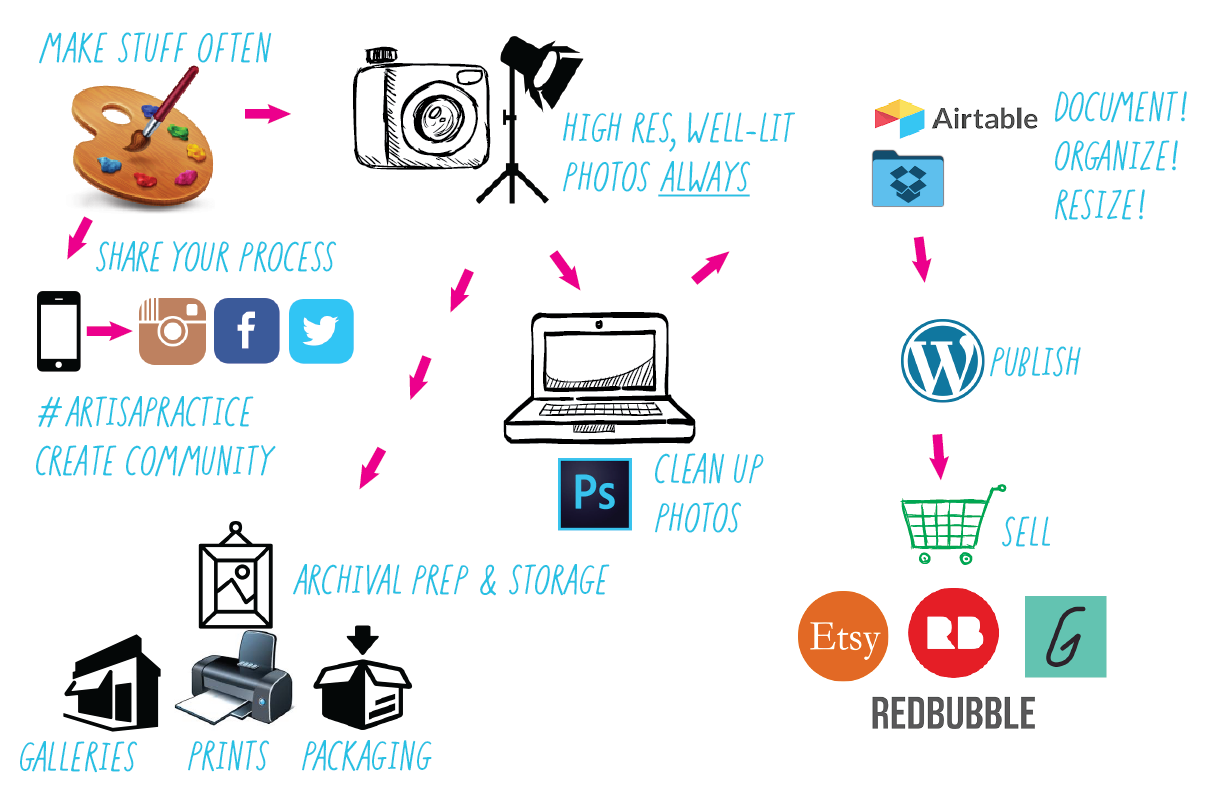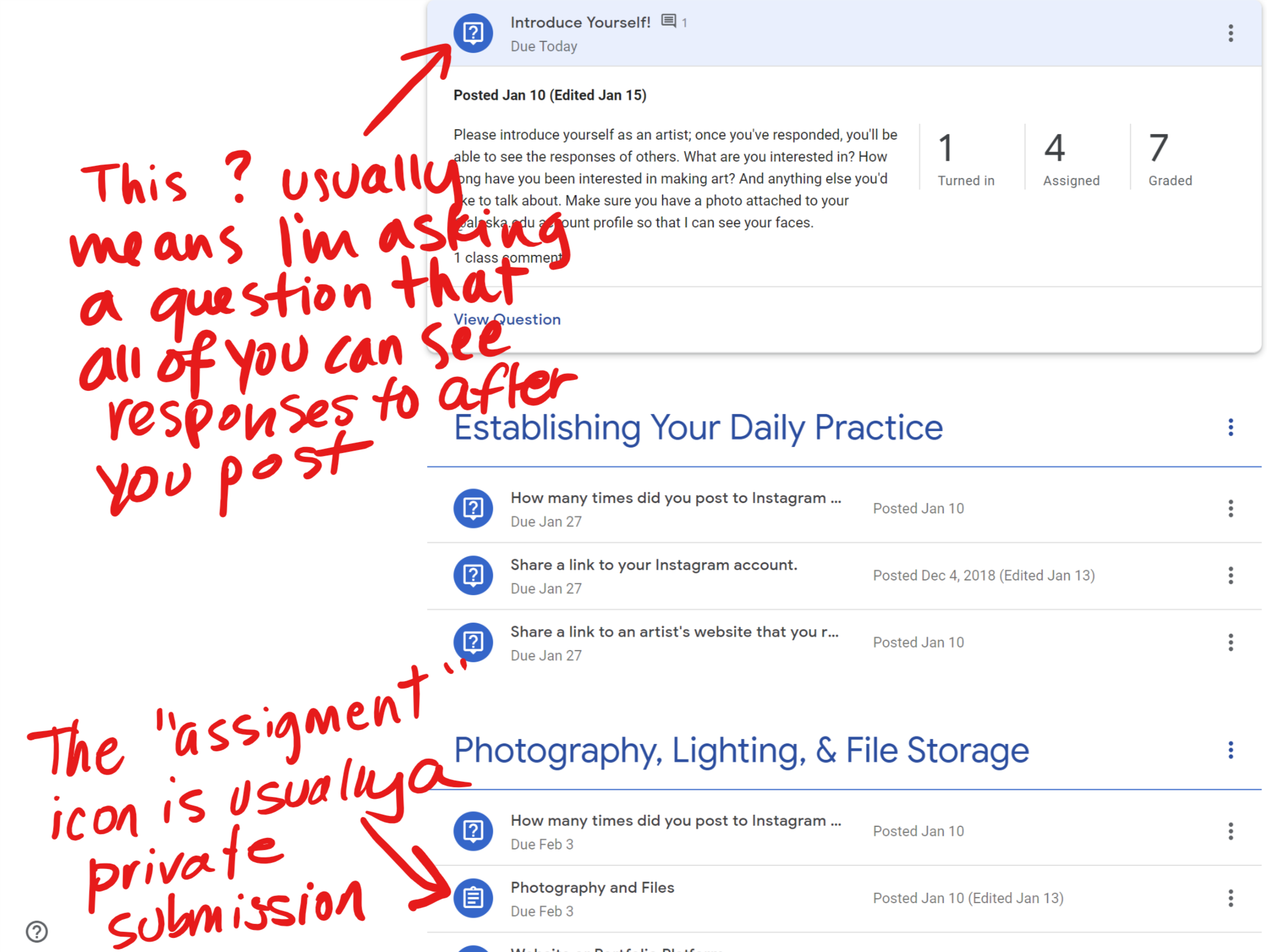Learning Objectives
- Think about your own workflow, what should be a part of it, and consider what you need to start and what you need to improve.
- Engage with Instagram and start crafting value.
- Research artist’s websites and share at least one you like.
- Consider what it means to behold the work of another artist.
I don’t even know what a traditional producer is or does. I feel like the job is like being a coach, building good work habits and building trust. You want to get to a point where you can say anything and talk about anything. There needs to be a real connection.
Beauty is in the Eye of the #beholder
I started watching the Shangri-La docuseries (available streaming with multiple providers) last night and there were two things in the first episode that I’ve been mulling over ever since. One, was simply confirmation that creatives who have committed to their practice are on the right track. Rick Rubin (a well known music collaborator and producer) was talking to LL Cool J and they were referring to it as “going fishing” and, I’m paraphrasing here, you might cast your line 200 times, but only catch 4 fish. But you can’t catch those 4 fish unless you’ve been out there doing the casting. Also, you can’t say “I’m going to go fishing today and catch 4 fish” because that’s not how it works. All you can do is show up and do the work, maybe some fish show up, maybe they don’t. That’s #artisapractice.
*
The other thing, I’m calling it #beholdingisapractice, took a while. Watching Rubin in this docuseries was fascinating. When he’s in the studio with musicians, he’s usually got his eyes closed and he’s very clearly into whatever the musician is bringing to the table. His body responds to all of it; he’s grooving. “Into a groove” This word, groove, is from the Middle English meaning a pit, mine shaft, or deep cave. Grooving is going down into the dark to find the things that matter. I’m no musician, but I can imagine no more satisfying feeling than to see my audience really get into a groove.
One of the questions that’s at the heart of Shangri-la is how Rick Rubin has managed to bring so many musicians out into the light and change our cultural musical landscape. He fosters and encourages the best work of so many artists, and there are lots of techniques he does to pull that out of people. But the technique that kept coming back to me all night long, and it’s an image I woke up with this morning, is the ability to be present and receptive and reflective to the art itself and to let the artist see all of that. Rubin’s ability to simply behold the music, not just listen to it, is magical. As an artist myself, I know how encouraging it is to find out that my work has resonated with someone; not that they just liked it, but that they got it, that it did something for them, makes me want to keep going. It makes all the hours in my studio feel worth it. To know that I made meaning for someone is everything.
But as a teacher, I’m not thinking about my own art only, I’m also thinking about how to cultivate the practice of others, and therefore usually on the lookout for new ways to most effectively do that. Watching Rick Rubin behold the practice of artists and (more specifically) the impact it has on those artists has evoked some powerful questions for me. What happens to me, not just as a teacher, but as an artist, when I make “beholding” a regular part of my practice? What does that mean to behold the art of others as part of my own creative life?
The answer to that perhaps lies in my belief that the most powerful art is often communal. It’s a shared experience between the one who is putting the art out there and the people who are seeing/reading/watching/listening to it, in other words: beholding it. The audience has to somehow reflect back to the artist the groove they’re in. The response to the art has to be embodied by the audience in a way that’s seen by the artist. That ancient “call and response” mechanism runs deep in us. At a time when we’re often beholding art in isolation, we have to find ways to reach out across the vastness of digital space and share our response to art. The response is just as important as the call and the artist has to be open to receiving that response in order to call back. This exchange between the two is the real currency of art.
If you’re reading this as a non-artist, know that beholding art, grooving with it, getting it, vibing on it…it’s an essential piece of the equation. It’s nearly as important as the art itself because it’s how art turns into shared cultural values, compassionate human experiences, and inflection points of change. You’re just as important as the artist. If you’re an artist, consider very intentionally beholding the art of others and focus on how you take it in, how you embody it and groove with it, and how you let the artist see your response. Try to practice both sides of the coin as an artist. Be generator and reflector. Be in conversation with your community. Let’s see #beholdingisapractice in action.
Also, I think it goes without saying that you should watch Sangri-la when you can. It’s right up there with Beauty is Embarrassing in my book.
Resources:
An article in Architectural Digest about what makes Rubin’s studio so conducive to creativity.
Shangri-La was directed by Won’t You Be My Neighbor?’s Morgan Neville and Jeff Malmberg
Rubin’s Wikipedia profile.
Not so glowing words from a musician who didn’t respond to Rubin’s style.
Beauty is Embarrassing – Another great documentary about artist Wayne White. (It’s for rent/purchase across the web)
*
Your Workflow
This week, we’ll be thinking about our workflow and how building a “professional profile” fits into it.
My Own Workflow
You should always pay attention to your artistic process: what inspires you, how your work gets made, materials you use, how often you revise work, how you know a piece is done, if you’re thinking about a particular audience, what concept or emotion you may be trying to evoke, and how your own history impacts your work.
This course is largely about what happens after your work gets made, but it’s also about the making itself; that’s the one thing all Professional Artists have in common…they make art. I’m going to ask you to think about your workflow this week and make your own illustration. You’re welcome to use mine as inspiration (copy from it as much as you like) or create your own. Your workflow can have items that you’re aiming for but don’t yet have or things you need to improve. Either way, think about ALL the things you need to do to be a professional artist.
Things on the horizon:
In this course, the work itself is the teacher for the most part. I rely on the fact that each of you wants to be a professional artist to be your motivation. The following are things you should be thinking about and working on, even if there isn’t an assignment due.
Remember that my real goal in having you on Instagram is to instill good (frequent) work habits. Art. Every. Day. Post a minimum of 4x per week and think about trying to actually engage in making art that often. My handle is @madaramasonart. I’m looking forward to following all of you.
Airtable
Start tracking now. I spent the first 15 years haphazardly tracking information about my art. There are literally hundreds of works that I never photographed or documented. Most of them are sold. There is no way for me to leverage that work as part of my portfolio now. TRACK your work!!!! Not just images, but dimensions, surface, materials, tags, and descriptions.
Cafe
If you have work you know will be used as “sample work,” go ahead and get a few images into your profile to be used later.
Portfolio Platforms
You’ll be committing to something by next week. You may want to try more than one:
- Wix
- Squarespace
- Google Sites
- Adobe Portfolio (I’m fairly certain you need an Adobe CC subscription to use this one)
- WordPress





